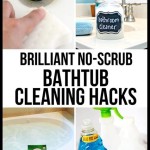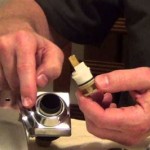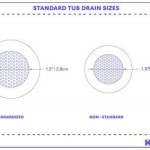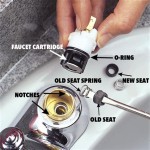How To Get A Fiberglass Bathtub White Again
Fiberglass bathtubs, known for their lightweight nature and relatively lower cost compared to other materials, often grace bathrooms across residential buildings. However, a common issue arises with these tubs: they tend to lose their pristine white appearance over time. This discoloration can stem from a variety of factors, including the buildup of soap scum, hard water deposits, mildew growth, and even the absorption of dyes from bath products. Restoring a fiberglass bathtub to its original white color requires diligence and the appropriate cleaning methods, ensuring the integrity of the material is maintained.
The task of whitening a fiberglass bathtub can seem daunting. The key lies in understanding the nature of the stains affecting the tub's surface and selecting the right cleaning agents and techniques. Avoid abrasive cleaners that can scratch the fiberglass surface, exacerbating the problem in the long run. Instead, focus on solutions that gently lift stains without causing damage. Preparation and proper execution are critical for achieving optimal results.
Identifying the Cause of Discoloration
Before embarking on any cleaning endeavor, it is crucial to identify the underlying cause of the bathtub's discoloration. Different types of stains require different approaches. Soap scum typically presents as a dull, grayish film, resulting from the reaction between soap and hard water minerals. Hard water stains, on the other hand, often appear as a white or yellowish, chalky residue. Mildew manifests as black or dark green spots, thriving in moist environments. Dyes from bath bombs, shampoos, or other products can penetrate the fiberglass, leaving behind colored streaks or patches.
Once the type of discoloration is identified, one can select the appropriate cleaning agents and techniques to address the specific problem. This targeted approach ensures efficient and effective stain removal, minimizing the risk of damaging the fiberglass surface.
For example, if soap scum is the primary culprit, a cleaning solution designed to dissolve soap scum buildup would be most effective. If hard water stains are prominent, a cleaner containing mild acids, such as vinegar or citric acid, may be necessary to break down the mineral deposits. Mildew requires a disinfectant solution specifically formulated to kill mold and prevent its recurrence. For dye stains, a stain remover with bleaching properties (used carefully and sparingly) may be required.
Choosing the Right Cleaning Agents and Tools
The selection of cleaning agents and tools is paramount to the success of the whitening process and the preservation of the fiberglass bathtub's integrity. Abrasive cleaners, scouring pads, and harsh chemicals should be avoided at all costs, as they can scratch the surface, creating microscopic crevices that trap dirt and stains, ultimately worsening the problem. Instead, opt for gentle, non-abrasive cleaning agents and soft cleaning tools.
Suitable cleaning agents for fiberglass bathtubs include: white vinegar, baking soda, dish soap, hydrogen peroxide, and commercially available bathtub cleaners specifically formulated for fiberglass surfaces. White vinegar is an excellent natural alternative for dissolving hard water stains and soap scum. Baking soda acts as a mild abrasive and deodorizer. Dish soap is effective for general cleaning and removing greasy residues. Hydrogen peroxide can be used to lighten stains and kill mildew.
The cleaning tools should be equally gentle. Soft cloths, sponges, and microfiber towels are ideal for scrubbing and wiping down the bathtub surface without causing scratches. A toothbrush can be used to reach tight corners and crevices. A spray bottle is useful for applying cleaning solutions evenly. Always test the chosen cleaning agent on a small, inconspicuous area of the bathtub first to ensure it does not cause any discoloration or damage.
Additionally, safety precautions should be observed when using any cleaning agent. Wear gloves to protect the skin from irritation and ensure adequate ventilation to avoid inhaling fumes. Always read and follow the manufacturer's instructions for the chosen cleaning product.
Step-by-Step Cleaning Process
Before beginning the cleaning process, it is essential to prepare the bathtub area. Remove any loose items, such as bath mats, shampoo bottles, and soap dishes. Rinse the bathtub thoroughly with warm water to loosen any surface dirt and debris. Ensure adequate ventilation by opening windows or turning on the bathroom exhaust fan.
The cleaning process typically involves the following steps:
- Apply the chosen cleaning agent: Depending on the type of stain, either spray the cleaning solution directly onto the affected areas or apply it with a damp cloth or sponge. For stubborn stains, allow the cleaning agent to sit on the surface for several minutes to allow it to penetrate and loosen the stain. The dwell time will vary based on the product, so follow the directions on the product's label.
- Scrub gently: Using a soft cloth, sponge, or microfiber towel, gently scrub the stained areas in a circular motion. Avoid using excessive force, as this can scratch the fiberglass surface. For hard-to-reach areas, such as corners and crevices, use a toothbrush.
- Rinse thoroughly: After scrubbing, rinse the bathtub thoroughly with warm water to remove all traces of the cleaning agent. Ensure that no residue remains, as this can attract dirt and contribute to future staining.
- Dry the bathtub: Use a clean, dry cloth or towel to dry the bathtub completely. This will help prevent water spots and mildew growth.
- Repeat if necessary: For particularly stubborn stains, the cleaning process may need to be repeated multiple times. If the stain persists after repeated attempts, consider using a stronger cleaning agent, but always test it on a small, inconspicuous area first.
For specific types of stains, the following techniques may be employed:
Soap Scum: Apply a solution of equal parts white vinegar and water to the affected areas. Allow it to sit for 15-20 minutes, then scrub gently and rinse thoroughly.
Hard Water Stains: Create a paste of baking soda and water and apply it to the stained areas. Allow it to dry completely, then scrub gently and rinse thoroughly. Alternatively, use a commercially available hard water stain remover.
Mildew: Mix equal parts bleach and water and apply it to the affected areas. Allow it to sit for 10-15 minutes, then scrub gently and rinse thoroughly. Ensure adequate ventilation and wear gloves when using bleach.
Dye Stains: Apply a paste of baking soda and hydrogen peroxide to the stained areas. Allow it to sit for several hours or overnight, then scrub gently and rinse thoroughly. Alternatively, use a commercially available stain remover with bleaching properties.
After the cleaning process, consider applying a wax or sealant specifically designed for fiberglass surfaces. This will help protect the surface from future staining and make it easier to clean.
Regular maintenance is crucial for preventing the recurrence of stains. Wipe down the bathtub after each use with a clean, dry cloth to remove excess water and soap residue. Ventilate the bathroom properly to prevent mildew growth. Avoid using harsh chemicals or abrasive cleaners on the fiberglass surface.

How Do I Get My Fiberglass Tub White Again Hometalk

How Do I Get My Fiberglass Tub White Again Hometalk

How Do I Get My Old Tub White Again Hometalk

How To Turn Your Bleach Stained Red Bathtub White Again 4 Steps With Pictures Instructables

How Do I Get My Fiberglass Tub White Again Hometalk

How To Refinish Your Bathtub For 50

How To Make Your Bathtub And Shower Tile Look New Again Life Should Cost Less

Cleaning Tips How To Clean Fiberglass

How To Clean A Yellowing Fiberglass Tub Hunker

How To Clean Your Fiberglass Tub








